A resistor is a fundamental electrical component that resists the flow of electrical current in a circuit. Its primary function is to limit the flow of current, control voltage levels, and divide voltages in a circuit. Resistors are designed to have a specific resistance value, measured in ohms (Ω), which determines how effectively they impede the flow of current.
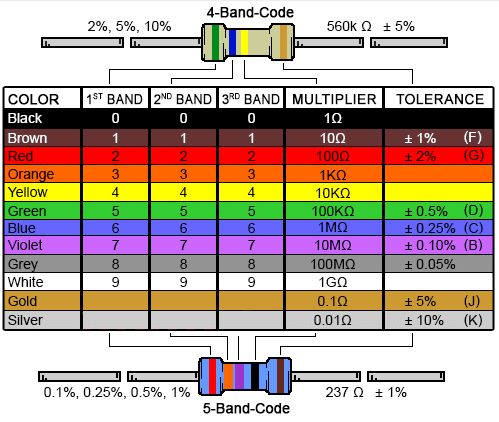
Resistors are used in electronic circuits for various purposes, including:
-
Current Limiting: Resistors are commonly used to limit the amount of current flowing through a circuit. By restricting current flow, resistors help protect components from damage due to excessive current.
-
Voltage Division: Resistors are used in voltage divider circuits to create intermediate voltages from a single source voltage. This is essential for providing specific voltage levels to different components in a circuit.
-
Load Resistance: In electronic circuits, resistors are often used as load resistors to simulate a load for testing purposes or to discharge capacitors safely.
-
Signal Processing: Resistors are crucial components in signal processing circuits. They can be used in amplifier circuits, filter circuits, and attenuators to modify the amplitude and characteristics of electrical signals.
-
Timing Circuits: Resistors, in combination with capacitors, are used in timing circuits to create precise time delays or oscillations.
-
Temperature Sensing: Some resistors, like thermistors and RTDs (Resistance Temperature Detectors), change their resistance with temperature. They are used in temperature sensing and compensation applications.
Resistors come in various types, including carbon film, metal film, wirewound, and variable resistors (potentiometers). Each type has unique characteristics that make it suitable for specific applications based on factors such as power rating, tolerance, and temperature coefficient.
In summary, resistors are fundamental components in electronic circuits, playing a crucial role in limiting current, controlling voltage, dividing voltages, and shaping signals. Their versatility and widespread use make them essential for practically all electronic devices and circuits.
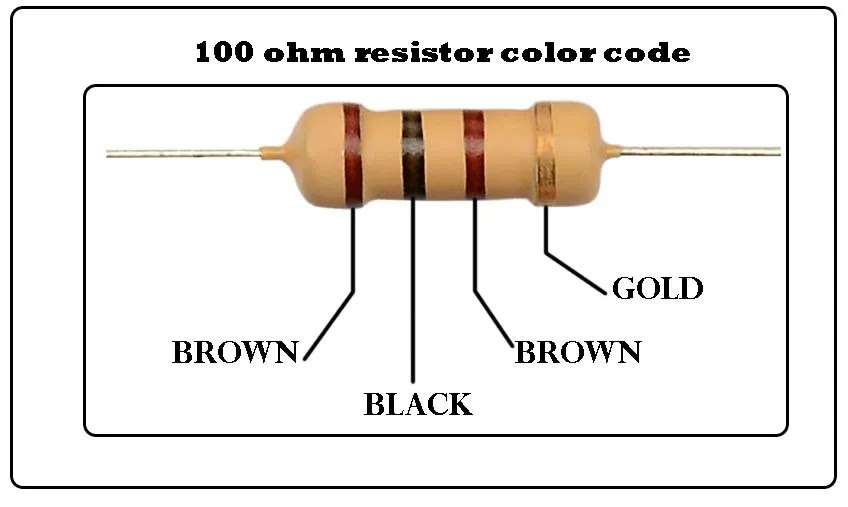
Examples:Calculating 10k/100 Ohm Resistor Color Code
Take a 4-band resistor as the example, 10k ohm resistor color code 4 band is: Brown-Black-Orange-Red. So the 1st band of Color: Brown, 2nd band: Black, Multiplier: Orange and Tolerance: Red. Thus, the output of resistor value is 10K ohms 2%. And the below picture shows you the 100 Ohm Resistor Color Code for 4-band resistors.
How to Read a Resistor Color Code Chart for 3/4/5/6 Band Resistors
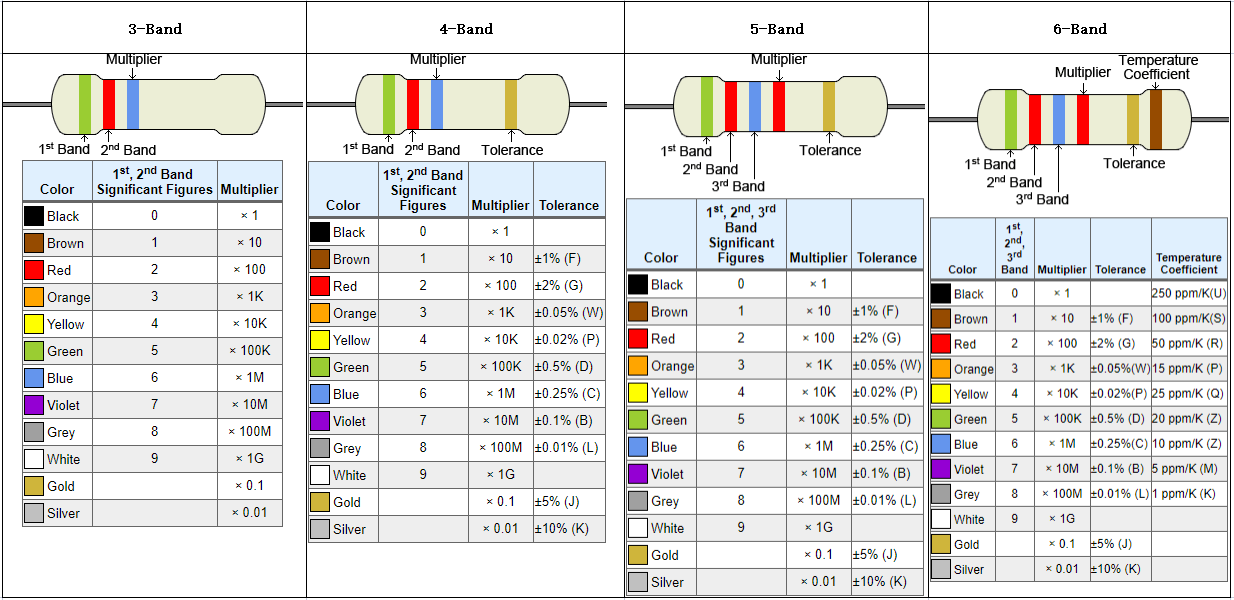
Reading the color bands on a resistor is a common way to determine its resistance value. The number of color bands on a resistor corresponds to the precision of the resistor. Here's how to read a resistor color code chart for 3-, 4-, 5-, and 6-band resistors:
3-Band Resistor Color Code Chart:
- Band 1 (1st Significant Figure): The first color band represents the first digit of the resistance value.
- Band 2 (2nd Significant Figure): The second color band represents the second digit of the resistance value.
- Band 3 (Multiplier): The third band represents the multiplier that determines the magnitude of the resistance value.
4-Band Resistor Color Code Chart:
- Band 1 and Band 2 (1st and 2nd Significant Figures): The first two color bands represent the first and second digits of the resistance value.
- Band 3 (Multiplier): The third band represents the multiplier that determines the magnitude of the resistance value.
- Band 4 (Tolerance): The fourth band indicates the tolerance of the resistor.
5-Band Resistor Color Code Chart:
- Band 1, Band 2, and Band 3 (1st, 2nd, and 3rd Significant Figures): The first three color bands represent the first, second, and third digits of the resistance value.
- Band 4 (Multiplier): The fourth band represents the multiplier that determines the magnitude of the resistance value.
- Band 5 (Tolerance): The fifth band indicates the tolerance of the resistor.
6-Band Resistor Color Code Chart:
- Band 1, Band 2, Band 3 (1st, 2nd, and 3rd Significant Figures): The first three color bands represent the first, second, and third digits of the resistance value.
- Band 4 (Multiplier): The fourth band represents the multiplier that determines the magnitude of the resistance value.
- Band 5 (Tolerance): The fifth band indicates the tolerance of the resistor.
- Band 6 (Temperature Coefficient): The sixth band represents the temperature coefficient of the resistor.
Colors and Number to Value Conversion:
- Refer to a resistor color code chart to accurately determine the resistance value based on the colors of the bands. Each color corresponds to a specific number, which can be used to calculate the resistance value following the band sequence provided in the charts.
By understanding and correctly interpreting the color bands on resistors according to the respective charts, you can determine their resistance values and ensure their proper usage in electronic circuits.
How To Read Resistor Color Code?
Reading a resistor color code involves decoding the colored bands on the body of the resistor to determine the resistance value, tolerance, and sometimes the temperature coefficient. Here's how you can read a resistor color code:
Steps to Read a Resistor Color Code:
-
Determine the Number of Bands:
- Count the number of colored bands on the resistor. This will help you identify whether it is a 3-, 4-, 5-, or 6-band resistor.
-
Identify the Colors:
- Each color band on the resistor represents a specific digit or value. Colors are mapped to numbers according to a standard color code.
-
Read the Bands:
- Start reading the colored bands from left to right (or right to left, depending on the orientation of the resistor).
- Note the color of each band and its position.
-
Decode the Color Bands:
- Use a color code chart to map each color to the corresponding number or value.
- Match the colors with the numbers as per the chart to determine the resistance value represented by the bands.
-
Determine Resistance Value:
- For a 3- or 4-band resistor, the resistance value is derived using the first two (or three) color bands as significant digits and the third (and fourth) band as the multiplier.
- For a 5- or 6-band resistor, the resistance value requires consideration of additional digits and a temperature coefficient if present.
-
Decode Tolerance and Temperature Coefficient:
- If applicable, the last (or last two) bands on the resistor indicate the tolerance of the resistor and, in the case of a 6-band resistor, the temperature coefficient.
-
Calculate the Resistance Value:
- Combine the significant digits with the multiplier to calculate the resistance value in ohms. The tolerance band determines the allowable percentage variation from this value.
-
Verify the Value:
- Once you have decoded the color bands, double-check your calculation and make sure it aligns with the expected resistance value based on the color bands.
Tips:
- Use a good lighting source to clearly differentiate between colors.
- Use a magnifying glass if needed for reading color bands on smaller resistors.
- Refer to a reliable resistor color code chart to assist in decoding the colors accurately.
By following these steps and reference materials, you can effectively read a resistor color code and determine the resistance value, tolerance, and other relevant information encoded on the resistor's body.
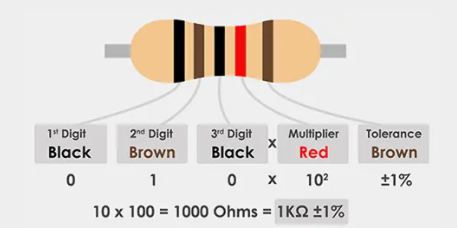
What is the purpose of resistor color codes?
Resistor color codes serve several crucial purposes in the realm of electronics and electrical engineering:
1. Resistance Value Identification:
- The primary purpose of resistor color codes is to indicate the resistance value of a resistor. By decoding the colored bands on the resistor, engineers and technicians can quickly determine the resistance value without needing to rely on additional documentation.
2. Component Identification:
- Resistor color codes help in the identification and categorization of resistors based on their resistance values. This aids in inventory management, troubleshooting, and circuit design.
3. Space Efficiency:
- Resistor color codes provide a compact and efficient method of displaying resistance values directly on resistors without requiring additional labels or markings. This is particularly useful in situations where space is limited, such as in small electronic devices.
4. Quick Visual Inspection:
- With the use of color codes, technicians and engineers can visually inspect a resistor and immediately know its resistance value, reducing the time needed for identification during circuit assembly, repair, or replacement.
5. Universal Standardization:
- Resistor color codes follow industry-standard conventions, allowing for consistency and uniformity in resistor labeling across different manufacturers and regions. This standardization simplifies the process of working with resistors from various sources.
6. Reduction of Errors:
- Using color codes helps minimize errors that may arise from misinterpretation of numerical markings or labels on resistors. The distinct color bands provide a clear and reliable method for determining resistance values.
7. Tolerance and Temperature Coefficient Information:
- In addition to resistance values, resistor color codes can also convey information about tolerance levels and temperature coefficients. This data is crucial for ensuring the accuracy and reliability of resistors in electronic circuits under varying conditions.
8. Educational Tool:
- Resistor color codes serve as a valuable educational tool for students and enthusiasts learning about electronics. By understanding and decoding color bands, individuals can deepen their knowledge of electronic components and circuitry.
In conclusion, resistor color codes play a vital role in facilitating the identification, categorization, and understanding of resistor values in electronic circuits. They streamline the process of working with resistors, improve efficiency in circuit design and troubleshooting, and ensure the accuracy and reliability of electronic systems.
Resistor Color Code Explained
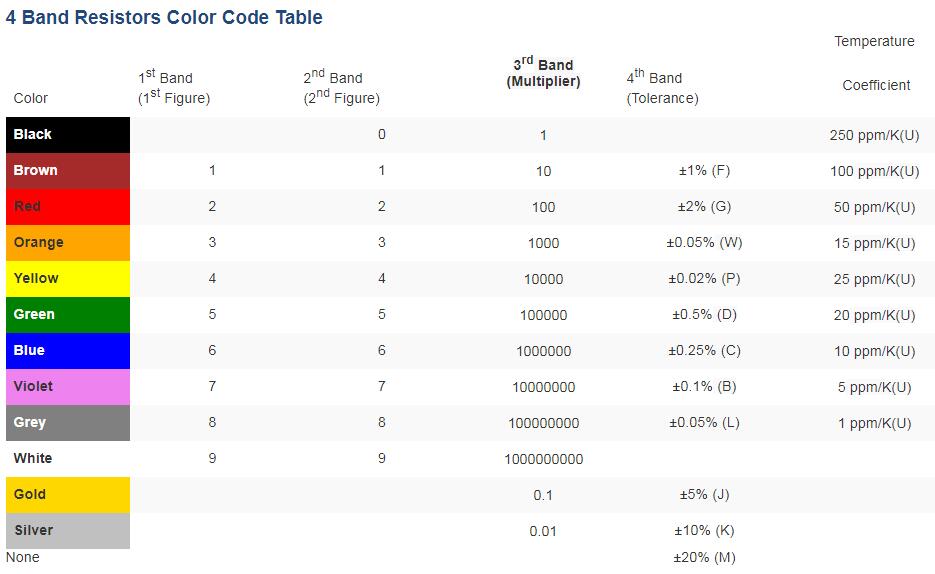
Resistor Color Code 5 Band
Five band Resistor Color Code Examples:
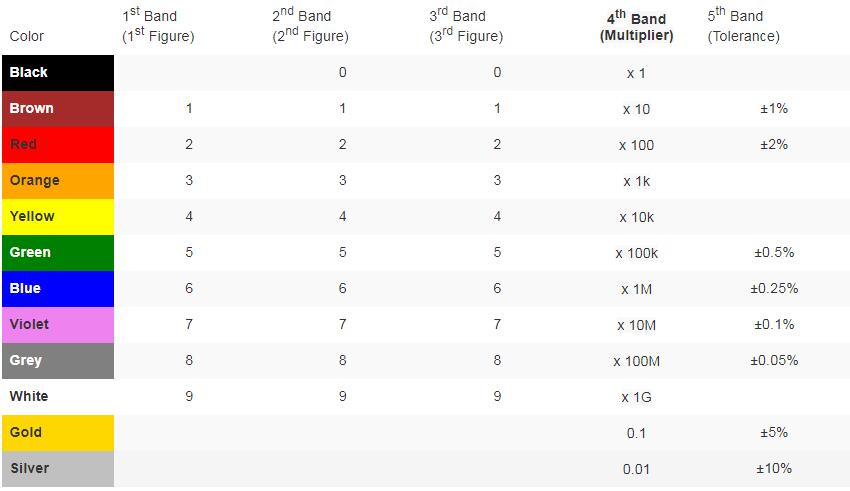
More examples of 5-band resistance color code:
A resistor colored Blue-Brown-White-Brown-Red
The values as, 6/1//9/10 = 619 x 10 = 6190 ohms (6.19K ohms). The tolerance is ±2% for Red. Thus, the resistor value is 6.07KΩ-6.31KΩ
6 Band Resistor Color Code
For high precision, Resistors with 6 bands usually have 6 band color codes. And mostly, the 6th band is colored with brown, which means that the resistance value can change 1000 ppm = 0.1%, for a temperature change of 10 ˚C. For example, a 6 band resistor colored Orange-Red-Brown-Brown-Green-Red would be 3.21 kΩ with a tolerance of ±1% and a 50 ppm/°C temperature coefficient.



